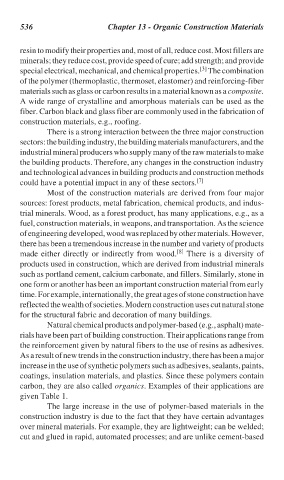Page 566 - Handbook of Thermal Analysis of Construction Materials
P. 566
536 Chapter 13 - Organic Construction Materials
resin to modify their properties and, most of all, reduce cost. Most fillers are
minerals; they reduce cost, provide speed of cure; add strength; and provide
[3]
special electrical, mechanical, and chemical properties. The combination
of the polymer (thermoplastic, thermoset, elastomer) and reinforcing-fiber
materials such as glass or carbon results in a material known as a composite.
A wide range of crystalline and amorphous materials can be used as the
fiber. Carbon black and glass fiber are commonly used in the fabrication of
construction materials, e.g., roofing.
There is a strong interaction between the three major construction
sectors: the building industry, the building materials manufacturers, and the
industrial mineral producers who supply many of the raw materials to make
the building products. Therefore, any changes in the construction industry
and technological advances in building products and construction methods
could have a potential impact in any of these sectors. [7]
Most of the construction materials are derived from four major
sources: forest products, metal fabrication, chemical products, and indus-
trial minerals. Wood, as a forest product, has many applications, e.g., as a
fuel, construction materials, in weapons, and transportation. As the science
of engineering developed, wood was replaced by other materials. However,
there has been a tremendous increase in the number and variety of products
[8]
made either directly or indirectly from wood. There is a diversity of
products used in construction, which are derived from industrial minerals
such as portland cement, calcium carbonate, and fillers. Similarly, stone in
one form or another has been an important construction material from early
time. For example, internationally, the great ages of stone construction have
reflected the wealth of societies. Modern construction uses cut natural stone
for the structural fabric and decoration of many buildings.
Natural chemical products and polymer-based (e.g., asphalt) mate-
rials have been part of building construction. Their applications range from
the reinforcement given by natural fibers to the use of resins as adhesives.
As a result of new trends in the construction industry, there has been a major
increase in the use of synthetic polymers such as adhesives, sealants, paints,
coatings, insulation materials, and plastics. Since these polymers contain
carbon, they are also called organics. Examples of their applications are
given Table 1.
The large increase in the use of polymer-based materials in the
construction industry is due to the fact that they have certain advantages
over mineral materials. For example, they are lightweight; can be welded;
cut and glued in rapid, automated processes; and are unlike cement-based

